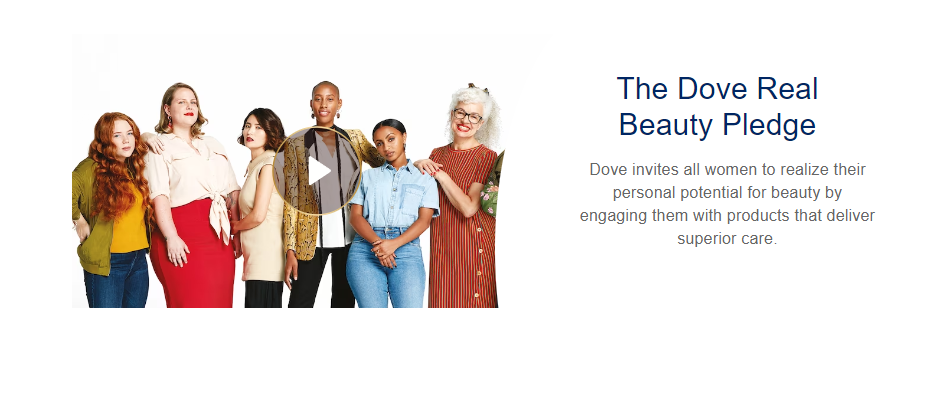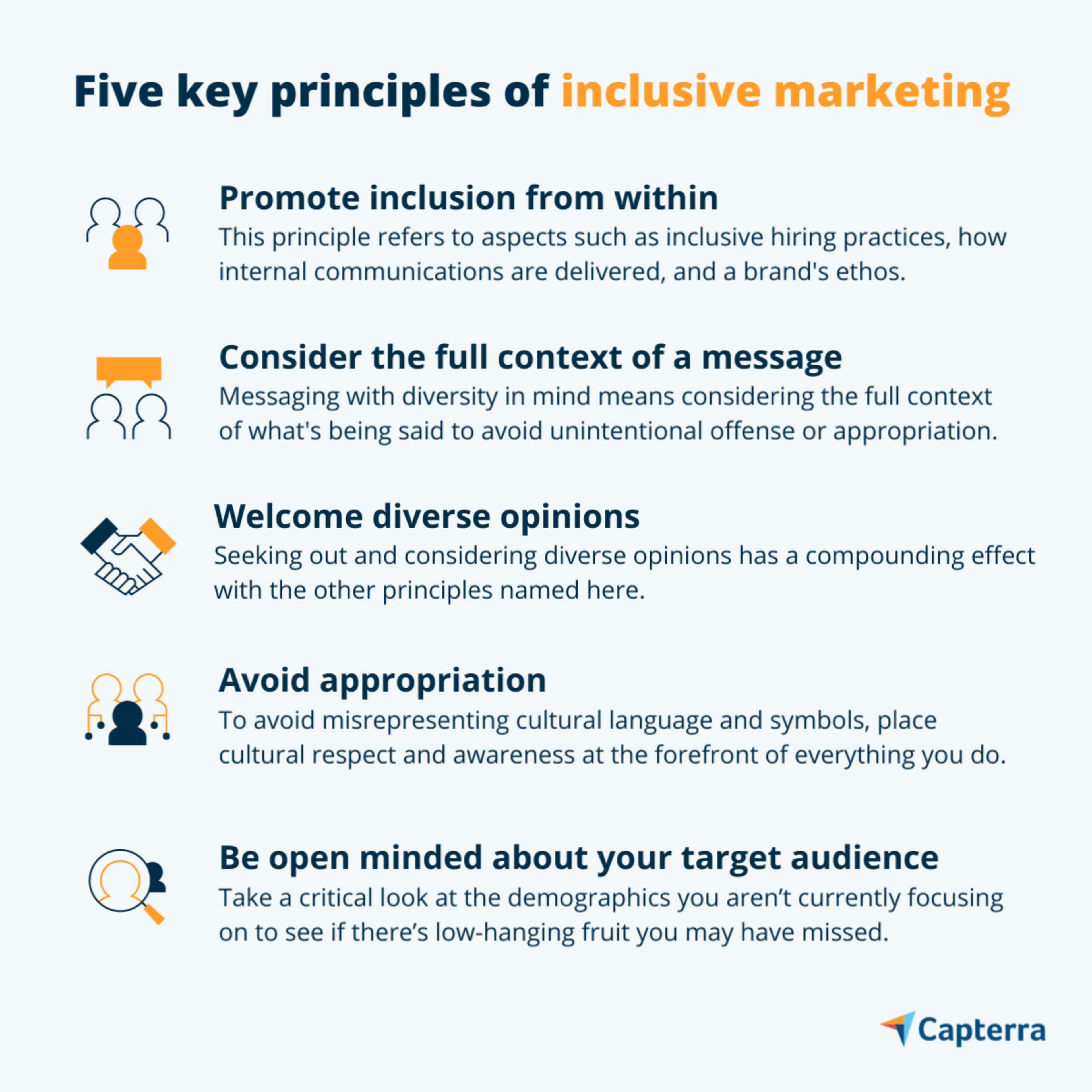Reach a broader audience with an inclusive approach to marketing your business.
When marketing for a small business it’s important to be specific with who you’re trying to reach, but is there a danger in being too specific? The short answer is yes.
Aside from the business benefits of reaching more people with your message, there are also ethical and social implications to being as inclusive as possible with your marketing.
Take an inclusive marketing approach with these tips from practicing pros to meaningfully engage with people from more backgrounds. You may discover there are new customers waiting for you in places you didn’t expect.
What is inclusive marketing?
Inclusive marketing refers to the process of crafting a business’ marketing messages with the goal of representing and reaching as many diverse perspectives as possible. At the base level, inclusive marketing highlights the diversity of a business’ target market audience within their advertising. Inclusive marketing can refer to how wide of an audience is targeted by marketing campaigns, the content of individual marketing messages, the breadth of perspectives involved in developing those messages, and the level of focus placed on inclusion from marketing leadership.

An example of an inclusive marketing campaign from Dove’s Real Beauty Pledge[1]
Why is inclusive marketing important?
Even more than that, though, inclusive marketing serves to elevate the voices of diverse perspectives, decrease cultural biases, promote diverse role models, and ultimately lead to positive social change through more representation.
From a cultural perspective it’s easy to see how being more inclusive can have a positive impact, but it’s also beneficial from a business standpoint. In fact, Gartner’s 2023 Consumer Community Survey identifies several benefits of engaging in inclusive advertising:

Conventional marketing wisdom dictates getting as specific as possible with a target audience. This is all well and good, and it does produce positive results, but what about being too specific?
Inclusive marketing combats the tendency to leave potential customers out of the equation by smartly and mindfully including groups that may not be prioritized through the traditional methods used to determine buyer personas.
Key principles of inclusive marketing
Regardless of where your business lies in terms of implementing meaningful inclusivity or what industry you’re in, there are some key principles of inclusive marketing that hold true in most situations.
Ranging from truly promoting inclusivity from within your organization to considering the context of every marketing message you send, abiding by these principles as you go will yield results that are both genuine and effective.
Promote inclusion from within
Promoting inclusion from within your own organization refers to aspects such as inclusive hiring practices, how internal communications are formulated and delivered, how leadership portrays themselves, and even the very ethos a brand is built around.
Some practical ways to accomplish promoting inclusion from a marketing standpoint include making sure everyone has a voice when it comes to marketing tactics and that constructive criticism is not only welcome but encouraged. This means including diverse perspectives in planning meetings, listening to constructive feedback around potentially harmful messages, and vetting campaign proposals with people that share the target audience’s background.
You can also promote inclusion from within in a long-term sense by hiring with diversity in mind. Cynthia Barnes, CEO and founder of the National Association of Women Sales Professionals (NAWSP)[2] puts it this way:
“If you want to attract a diverse buying market, you've got to make sure your sales team represents the buyer you're going after. There are customers who are going to say, ‘I'm not going to buy from you because no one looks like me.’”
There are ways both big and small to promote inclusivity within, and—as you can see—these methods have effects that can originate from your very brand essence and ripple all the way out to the customer experience.
/ Related reading
Want to hear more from Barnes on her commitment to promoting inclusive sales and marketing? Read our article on the topic here: Sales Trailblazer Shares Her Secrets for Driving Business Growth Through Inclusive Sales
Consider the context of a message and be intentional with language
Every piece of marketing comes with a message. When crafting messages for a diverse audience, you have to consider the full context of what you’re saying to avoid unintentionally offending, misrepresenting a group, or culturally appropriating (more on this later). Barnes favors a technological approach to tackle this, and we agree:
“There are [sales enablement tools] out there that will analyze your marketing messages to find out whether or not they contain bias, microaggressions, etc.”
This type of automation is invaluable as it helps control for the innate human biases that cause messaging issues in the first place. Even with the best intentions, you may be unaware that the context of a message is potentially harmful to a certain group. Using technology like a sales enablement platform as a failsafe adds another crucial line of defense.
Another vital aspect to a message’s context is the intentionality put behind the language used. Words, phrases, and symbols have different meanings to different groups, and it’s important to analyze your messaging to make it as inclusive as possible. After all, as Barnes says, “If there's something you can do to make your language more inclusive, then why not?”
Welcome diverse opinions
Diversity and inclusion go hand in hand, so it stands to reason that welcoming diverse opinions is a key tenet of promoting inclusivity in marketing. Seeking out and considering diverse opinions has a compounding effect with the other principles named here.
What we mean is that welcoming diverse opinions is a way to promote inclusion from within, and those opinions allow you to be more intentional and inclusive with language as well as avoid pitfalls like unintentional appropriation.
When asked about the best ways to accomplish this, Dan Rauchwerk, email marketing specialist for Atlanta Dog Rescue Cafe (ARDC)[3], is a major proponent of:
“Ensuring that you have a diverse marketing team, any way that you might define diversity. People with different cultural backgrounds and different levels of experience will pick up on different things.”
And diverse opinions can come from both internal and external sources—ideally both. Include as many different internal perspectives as possible when planning marketing campaigns or producing marketing messaging. Also, survey your customers—through email, social posts, or website forms, etc.—to gather their opinions as well. Ultimately, your customers’ wants and needs should be your North Star, and that applies in this context as well.
Avoid appropriation
One of the easiest faux pas to commit when striving for more diversity and inclusion in marketing is cultural appropriation. Appropriation is defined as using aspects originating from a minority culture without understanding or respecting the meaning behind them. Gleaning cultural aspects from a group you’re trying to reach and working them into your messaging might seem like a good idea, but the sensitivities around this are very real and valid.
It’s impossible to understand all the cultural connotations a symbol or concept might have if you’re not part of a group, so it’s incredibly important to place cultural respect and awareness at the forefront of everything you do.
One way to avoid this common pitfall is to refer to the previous principles we’ve discussed, namely promoting inclusion from within, considering the full context of a message, and welcoming diverse opinions in your own organization. Applying these principles in a meaningful way lays the groundwork for respectful and authentic representations of culture—both in your marketing efforts and the workplace at large.
Be open minded about your target audience
Last but not least, being open minded about your target audience will help you be more inclusive, be more effective, and you may discover opportunities that you didn’t know existed. For example Matt Addison, founder and CEO of Rugged Black[4], a clothing company founded on celebrating black culture, discovered that even though the brand was created to speak to a specific audience he had fans in unexpected places:
“The difference between buyer personas you create and the ones that actually resonate is important to consider. We’re targeting young urban black males and realized that older people loved athleisure too.”
It’s easy to become hyper focused on your primary buyer persona. After all, you likely put a significant amount of time and energy into developing it. However, don’t lose the forest for the trees here. Instead, take a critical look at the demographics you aren’t currently focusing on to see if there’s low-hanging fruit you may have missed. You can even treat it as a thought experiment and develop buyer personas specifically for groups you don’t typically target.
Putting it all together: Resources needed and challenges of adopting an inclusive approach to marketing
The challenges of meaningfully adopting inclusive marketing principles and the resources needed vary from organization to organization. Some businesses may already have a diverse workforce and some may operate in an industry that has an inherently diverse audience, but there is work to be done no matter what stage you’re in.

First, examine your technology. As mentioned above, sales enablement platforms often have checks and balances in place to avoid potentially harmful marketing language. CRMs and customer data platforms feature advanced audience segmentation functionality that allows you to track the diversity of your target audience with more granularity.
Second, examine your workforce and hiring practices. To make meaningful long-term change promoting diversity, it has to start from within. Ensure that you aren’t excluding diverse talent from your hiring practices and that you’re properly elevating the perspectives of all groups within your marketing team.
When undergoing this process, it’s essential to acknowledge the potential costs associated. It’s not always possible to simply buy new technology or hire new people. Start by assessing the current state of your organization, noting areas for improvement and creating a roadmap to meaningful change that can earn buy-in from leadership.
Taking this measure twice and cut once approach to further investment ensures you don’t have a knee-jerk reaction in promoting diversity that a) doesn’t produce positive results and b) wastes precious resources. However, at the end of the day promoting inclusivity in your marketing is just the right thing to do. It has social benefits in addition to business benefits, and increasingly savvy consumers recognize when a business stands up for its values.
Eager to learn more about responsible marketing and the world of digital marketing in general? Visit the Capterra blog for more information, and start with these resources:
